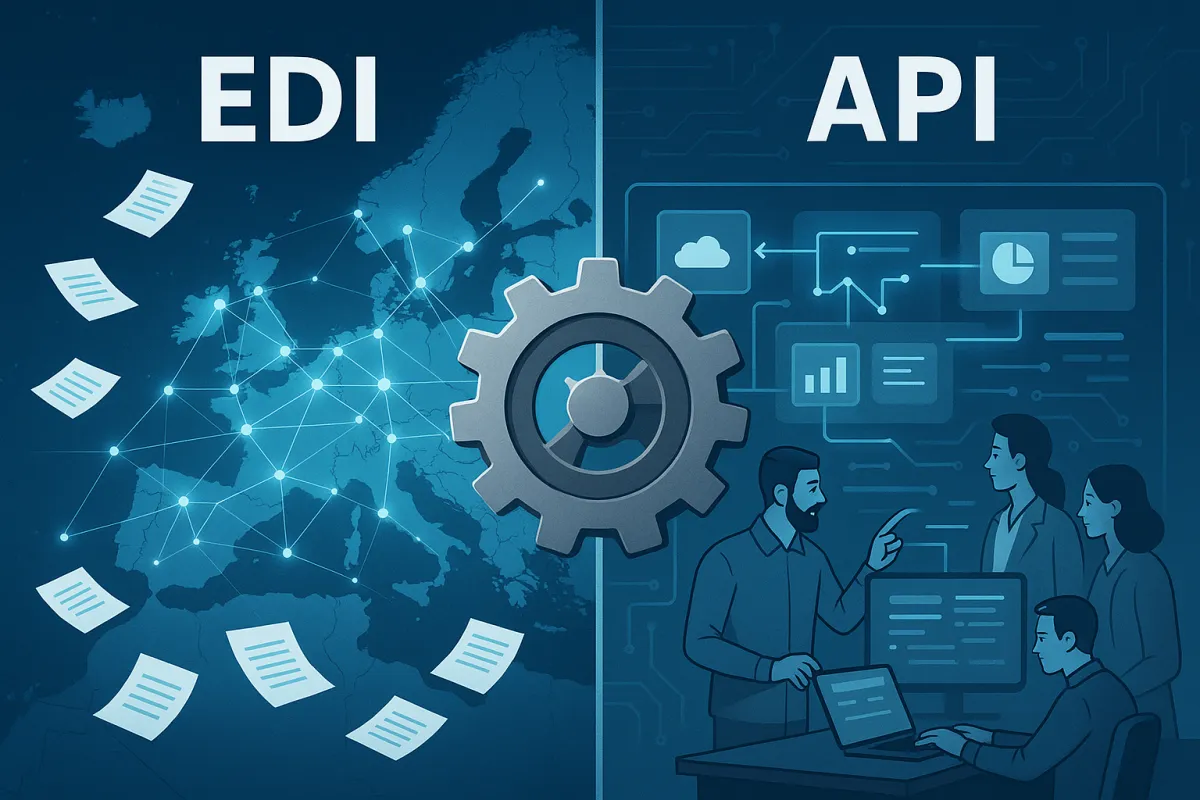Hybrid EDI/API Integration: The Complete Cost-Reduction Guide for European Manufacturers and Retailers in 2025

European manufacturers and retailers face a harsh reality: traditional single-technology approaches to carrier connectivity are hemorrhaging costs. Saint-Gobain saved 92% costs per line order by automating manual data entry with EDI processes, while GSF improved B2B transaction efficiency at least 25% with Boomi EDI. These aren't outliers—they represent what happens when companies embrace hybrid EDI/API integration strategies.
The numbers tell a compelling story. EDI integration proves to be a cost-effective solution, representing only a third of the expenses incurred with paper-based processes. But here's what most people miss: combining EDI's structured reliability with API's real-time flexibility can deliver cost reductions of 25-35% while maintaining full compliance across European markets.
Understanding the Hybrid EDI/API Integration Model
Think of hybrid integration as speaking two languages fluently instead of being limited to one. EDI lets organizations transmit massive volumes of data among suppliers and trading partners, and APIs enable real-time access to that data. You can use EDI and APIs to better integrate with trading partners and enable omnichannel fulfillment options.
Here's a practical example: Your warehouse management system receives a large purchase order via EDI 850 (reliable, standardized, batch processing). But when a customer calls asking about their shipment status, your customer service team needs that information now. An API can query the carrier's real-time tracking system and provide an immediate answer. APIs may be necessary to look up catalog inventory or check pricing within an eCommerce platform. If a customer decides to make the order, EDI may be necessary to kick-start the ordering, shipping, and fulfillment processes.
The architecture works because each technology handles what it does best. EDI excels at handling high-volume, standardized transactions, while APIs enable real-time, flexible data exchange. By understanding their strengths, businesses can strategically use both to create a connected, agile supply chain that balances stability with speed and adaptability.
The Business Case: Quantifying Cost Savings and ROI
Let's cut through the marketing fluff and examine real numbers. IBM's data shows companies can onboard new trading partners 1.5 weeks sooner with proper integration platforms. That's not just faster—it's revenue you're not leaving on the table.
The cost structure comparison reveals why hybrid approaches win. Traditional EDI-only solutions work well for high-volume, standardized transactions, but they struggle with modern business requirements. API-only approaches offer flexibility but can become expensive and complex when managing hundreds of trading partners with different technological capabilities.
Implementing and maintaining API-based systems tends to be more economical in the long term, avoiding the costs associated with the constant maintenance of EDI systems. Moreover, APIs offer better scalability, accommodating growing data needs without extensive reconfiguration. However, the real magic happens when you combine both approaches strategically.
Consider the operational efficiency gains: The synergy of EDI and API contributes to cost reduction. Integrating EDI and API promotes enhanced data validation processes, which ensure the accuracy of data before transmission or further processing.
Implementation Strategy: 5-Phase Deployment Plan
Most integration projects fail because companies try to boil the ocean. Here's a proven approach that minimizes disruption while maximizing benefits.
Phase 1: Assessment and Partner Mapping
Start by categorizing your trading partners. Large manufacturers like Siemens or Volkswagen suppliers typically have established EDI capabilities. Smaller regional carriers or newer logistics providers often prefer APIs. Implementing a hybrid solution should begin with an assessment of enterprise needs, considering system diversity among partners and the requirement for supply chain agility. Hybrid EDI can bridge different data sources, systems, or applications, fostering a seamless flow of information among companies with varying hosting infrastructures.
Phase 2: Pilot Program with High-Impact Partners
Choose 3-5 partners representing different categories—one major EDI-established partner, one API-native startup, and one hybrid candidate. This gives you real-world data on how each approach performs with your specific business requirements.
Phase 3: Platform Selection and Core Setup
Your platform needs to handle both protocols seamlessly. EDI and web service APIs can work together seamlessly and complement each other on one platform. That's why APIs are often part of a B2B integration strategy, adding real-time access to all sorts of B2B transactions. Real-time (API) and file-based batch (EDI) processes complement each other seamlessly when these processes are running on the same platform and can interact with each other.
Phase 4: Gradual Migration and Optimization
Don't try to migrate everyone at once. Roll out in waves, learning from each deployment. Use APIs in your Managed File Transfer or B2B gateway to facilitate faster partner onboarding — for EDI or API integrations — and reduce the time and costs of onboarding.
Phase 5: Scaling and Continuous Improvement
Monitor performance metrics, cost per transaction, and partner satisfaction. Use this data to optimize your technology mix for new partners.
Platform Selection Criteria: Evaluating Hybrid Solutions
Not all integration platforms are created equal. When evaluating solutions, focus on these critical capabilities:
Protocol Support and Standards Compliance
Your platform must support both EDIFACT (European standard) and APIs without forcing you to choose one or the other. Support X12, EDIFACT, TRADACOMS, HL7, and FHIR standards is table stakes for European operations.
Drag-and-Drop Mapping Tools
Quicken setup and reduce maintenance costs with pre-built connectivity to key ERP and CRM applications, workflow automation, and data readiness. Look for platforms that don't require deep technical expertise for basic configurations.
Pre-built Connector Ecosystem
The major players in this space include IBM Sterling B2B Integrator, Boomi, and MuleSoft. Direct API/EDI connections to 1,500+ carriers globally, with strongest coverage in Europe is what Cargoson offers, positioning itself among established solutions like these larger enterprise platforms.
Each platform has trade-offs. IBM Sterling offers enterprise-grade capabilities but comes with complexity. Boomi provides strong cloud-native features. Cargoson was designed as a hybrid between a transport management system (TMS) and a multi-carrier shipping software. Built specifically for European manufacturers, wholesalers and retailers (and not for carriers), it handles everything from small parcels to full truckloads, air and sea freight with complete carrier neutrality.
Real-World Success Stories: European Implementation Cases
The proof is in actual deployments, not vendor promises. Formica boosted their B2B transaction volumes by nearly 40% with an improved EDI platform. Li & Fung handles 1.5 million transactions an hour by standardizing workflows with EDI.
Manufacturing Sector Implementation
A mid-sized German automotive parts manufacturer implemented hybrid integration for their 150+ supplier network. EDI handles their high-volume transaction sets with Tier 1 suppliers (purchase orders, shipping notices, invoices). APIs manage real-time queries from smaller suppliers and provide immediate status updates to their ERP system.
Retail Sector Case Study
A European fashion retailer with operations across 12 countries uses EDI for bulk inventory transfers between distribution centers and APIs for real-time stock queries from individual stores. This hybrid approach reduced inventory discrepancies by 60% and improved response time for stock allocation decisions.
Wholesale Distribution Success
Ekol Logistics noted "Our confidence in Boomi stems from the seamless ease of use of the platform" and achieved improvements in transaction efficiency. The key was not replacing their existing EDI infrastructure but augmenting it with API capabilities for specific use cases.
Common Pitfalls and How to Avoid Them
Yes, another API change—sound familiar? The complexity multiplies when you're managing both EDI and API connections. The implementation of a hybrid EDI-API system requires navigating the complexities of data formats and workflows unique to each. This process calls for careful planning and a robust understanding of both technologies to ensure seamless integration.
Data Format Conflicts
Your biggest challenge will be maintaining data consistency between structured EDI documents and flexible API payloads. Establish clear mapping rules early and test thoroughly. A unified EDI and API strategy minimizes data inconsistencies by establishing a central source of truth for data exchanges.
Workflow Integration Issues
Don't assume your existing business processes will work unchanged. Exchanging data with ERPs, TMS, WMS, and finance systems is generally difficult with X12 standards because application-specific APIs are required to seamlessly integrate in real time with such back-end applications. Plan for process modifications, not just technical integration.
Partner Onboarding Complexity
Each new partner might require a different approach. Some will insist on EDI, others will demand APIs, and some won't care as long as it works. You can use APIs to offer partner self-service integration for EDI and APIs, and automate parts of the partner onboarding process. For example, you could provide self-service onboarding for EDI data exchanges and automate the process of arranging EDI data into the proper format. With APIs, you could perform automated credit checks when onboarding new partners and let partners customize integrations to suit their systems, whether they choose EDI or APIs.
Maintenance Overhead
Here's what most people miss: hybrid systems can increase complexity if not properly managed. Cross-training staff on legacy EDI and modern APIs leads to a smoother transition and implementation of hybrid EDI and API integration solutions. Investing in platforms capable of integrating a broad spectrum of networks and devices is crucial for handling integration complexities effectively.
The bottom line? Hybrid EDI/API integration isn't about replacing one technology with another—it's about using each where it makes the most sense. This hybrid approach allows businesses to combine the benefits of both EDI and API, ensuring efficient and seamless integration across their entire ecosystem. When implemented correctly, you'll reduce costs, improve partner relationships, and build a more resilient supply chain that can adapt to whatever changes come next.
Ready to start? Begin with your assessment phase. Map your current partners, identify your highest-impact integration candidates, and choose a platform that genuinely supports both protocols. The 25-35% cost reduction won't happen overnight, but with the right approach, it's absolutely achievable.
